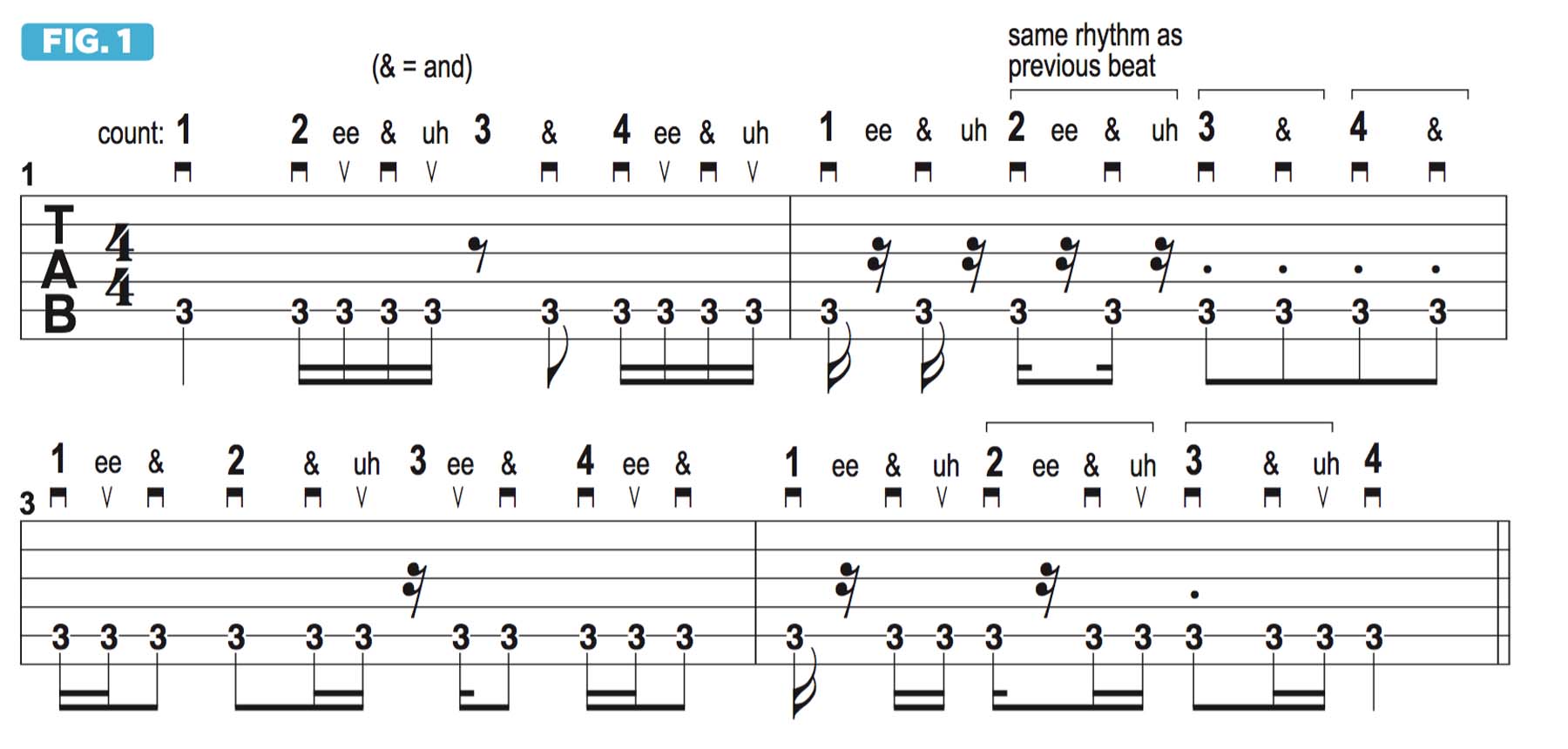How 16th-note rests can shake up your rhythm guitar playing
This introduction will take you from the basics to more tricky syncopated rhythm lines
As we learned previously, every rhythmic note value has a corresponding rest of equal duration. For example, in 4/4 meter, a quarter note occupies one full beat, as does a quarter rest.
Likewise, an eighth note and an eighth rest each take up half a beat. Well, the same holds true for 16th notes and 16th rests, which we will explore in this lesson, both of which occupy one quarter of a beat.
Last time, we learned how to subdivide a bar of 4/4 meter into four “quads,” which are groups of four 16th notes, and count them as follows: “1 ee and uh, 2 ee and uh, 3 ee and uh, 4 ee and uh.”
I’ll now show you how 16th rests are notated and offer examples of how they can be used in combinations with 16th notes and other rhythmic values to create a variety of rhythms and some interesting and tricky-sounding syncopations, or accentuations of what are normally considered the “weak” parts of the beat.
Before we get into anything complex, let’s look at a few ways in which 16th notes and rests can be combined without any syncopation, using only one repeating note, C (see Fig 1).

Notice that a 16th rest, first appearing in bar 2, has a double “hook,” as compared to the single hook of an eighth rest. Also notice that, in bars 2, and 4, I’ve repeated the same rhythm but notated it differently, first with a 16th note followed by a 16th rest, then with a staccato eighth note.
As you recall, the staccato mark – that small back dot placed directly above or below a note – tells you to shorten its rhythmic value, or duration, by 50 per cent. So a staccato eighth note takes the place of a 16th note and a 16th rest, making it a simpler and more economical notation that’s easier to read and mentally process.
As always, tap your foot on each beat as you play while counting out the subdivisions. Start out slowly, using all downstrokes at first
Still looking at bars 2 and 4 of Fig 1, notice also how, on beat 1 in each of these bars, a single 16th note may be indicated with a double flag attached to its stem, which matches the double hook of the 16th rest.
Alternatively, it can be beamed with other 16th notes that fall within the same beat, even if there’s a rest separating them, as illustrated in beat 2 of bars 2 and 4. Here, the 16th notes are connected by a single horizontal beam below the stems, what’s known as the primary beam, which is used for eighth notes, and a partial, or “broken,” secondary beam is added to indicate each single 16th note.
Again, I’m presenting these alternate notation options as examples of acceptable, common ways in which 16th-note rhythms are written, so that you’ll be able to recognize and read them when you come across them and also know how to notate them yourself.

Our next example is going to include a few syncopations, with 16th rests falling on either the first or third 16th-note “slot” of the beat. This would be either the beat number or the “and” count, allowing for 16th-note syncopations to occur on the second or fourth 16th-note slots, meaning the “ee” or “uh” counts.
And again, for the sake of focusing strictly on the rhythms, we’ll just use one repeating note, in this case, E (see Fig 2).
As always, tap your foot on each beat as you play while counting out the subdivisions. Start out slowly, using all downstrokes at first.
Then, once you feel you’ve mastered the rhythms, try playing each example again at a faster tempo, this time using what I call 16th-note “pendulum picking,” which is a continuous down-up-downup motion of the pick hand across each beat, regardless of whether or not you’re picking every 16th note.
As you’ll see in the picking prompts above the tabs here, any note that falls on the first or third 16th note of a beat is to be picked with a downstroke and any note that falls on the second or fourth 16th note (on "ee" or "uh") is to be picked with an upstroke. Using this technique will help ensure a flowing rhythmic feel.
Get The Pick Newsletter
All the latest guitar news, interviews, lessons, reviews, deals and more, direct to your inbox!
Over the past 30 years, Jimmy Brown has built a reputation as one of the world's finest music educators, through his work as a transcriber and Senior Music Editor for Guitar World magazine and Lessons Editor for its sister publication, Guitar Player. In addition to these roles, Jimmy is also a busy working musician, performing regularly in the greater New York City area. Jimmy earned a Bachelor of Music degree in Jazz Studies and Performance and Music Management from William Paterson University in 1989. He is also an experienced private guitar teacher and an accomplished writer.
"Upgrading from your entry-level acoustic opens the door to an entirely new world of tonewoods, body shapes, and brands": 6 signs it's time to upgrade from your first acoustic guitar
"I'm past my prime": 5 common excuses for not learning the guitar – and 5 body and mind-boosting reasons you should











